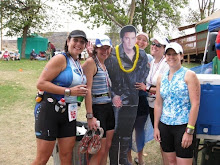Triathlete magazine
Any good orthopedist or physical therapist knows pain in one part of the body is often caused by dysfunction in another part of the body. The most common area of pain in swimmers is the shoulder rotator cuff.
Swimmer's shoulder is a form of bursitis that develops when a bursa, or fluid sack, located at the shoulder rotator cuff is repeatedly impinged during the swim stroke and becomes inflamed. Repetitive impingement may also cause tendonitis (inflammation) or tendinosis (tissue degeneration) in the tendons of the rotator cuff.
The primary cause of swimmer's shoulder is not the rotator cuff, however; it's the scapula. Commonly known as the shoulder blades, the left and right scapulae are strategically positioned as critical links between the spine and the shoulder rotator cuffs.
Essentially, the scapulae and the 17 muscles around them are the foundation of your shoulders and the base of every arm movement. A healthy shoulder blade must be both stable and mobile. Lack of adequate stability or mobility in the shoulder blade makes the rotator cuff susceptible to impingement during overhead arm movements such as those involved in the freestyle swim stroke.
Posture Problems
Healthy shoulder blades are a rarity in our society. The problem is the amount of time we spend sitting in front of computers and steering wheels. The hunched position we tend to assume in these situations leads to a more or less permanent forward rounding of the upper spine, called kyphosis.This posture inhibits the ability of the scapula to tilt backward and create space for the rotator cuff in the shoulder joint when the arm is lifted overhead. As a result, the rotator cuff gets pinched, causing tissue damage.
It doesn't stop there. In the keyboard-typing and steering-wheel-grasping positions our shoulders are internally rotated and protracted (pushed forward) for long periods of time. This leads to laxity and weakness in the muscles that externally rotate and retract (pull back) the shoulders.
Eventually, these imbalances cause the shoulder blades to float away from the spine toward the shoulder sockets, a phenomenon known as scapular winging. A healthy shoulder blade is sucked up tight against the ribcage. If your shoulder blades are visibly poking out of your upper back when you stand with your arms at your sides, then you have scapular winging.
Swimming tends to exacerbate these issues further, while also hastening and intensifying their consequences. Swimming strengthens the shoulder's internal rotators and protractors at the expense of the muscles that move the shoulders in the opposite directions.
To improve your shoulder health and performance, it's necessary to counterbalance these effects with strengthening exercises for the muscles that externally rotate the arms at the shoulder socket and retract the shoulder blades. A little bit of corrective exercise for the shoulders goes a long way.
I recommend doing one set of each of the following three exercises twice per week as a preventive measure if you have never experienced swimmer's shoulder. Build to two sets of each exercise three times per week if you have had a shoulder injury.
(Thanks to Eric Cressey, M.S., C.S.C.S., a Boston-based strength and conditioning coach who works with endurance athletes including Dede Griesbauer, second at Ironman Brazil this year, for teaching me these exercises.)
Scapular Push-up
The scapular push-up strengthens the serratus anterior, a muscle that essentially holds the shoulder blade tight to the rib cage to prevent scapular winging. It's a crucial muscle for optimal shoulder stability.

Behind-the-Neck Band Pull-Apart
This exercise strengthens the lower trapezius muscles, which are very important for adequate scapular upward rotation and overall shoulder health.Stand with your arms extended straight overhead and grasp a short resistance band with your hands at shoulder width and palms facing forward. By pulling the shoulder blades back and down and flexing the elbows, lower the band to a position behind your neck. The band will stretch several inches as this action is performed.

Overhead External Shoulder Rotation
This exercise strengthens the shoulder external rotators, enhancing shoulder stability during the performance of overhead arm actions.Stand with your right upper arm extended away from your body at shoulder level, your elbow bent 90 degrees and your shoulder rotated internally so your forearm is pointing toward the floor (in line with your body). Hold a small dumbbell (three to five pounds) in your right hand.

All Photos by John Segesta/wahoomedia.com





















No comments:
Post a Comment